Asus X56VR User Manual
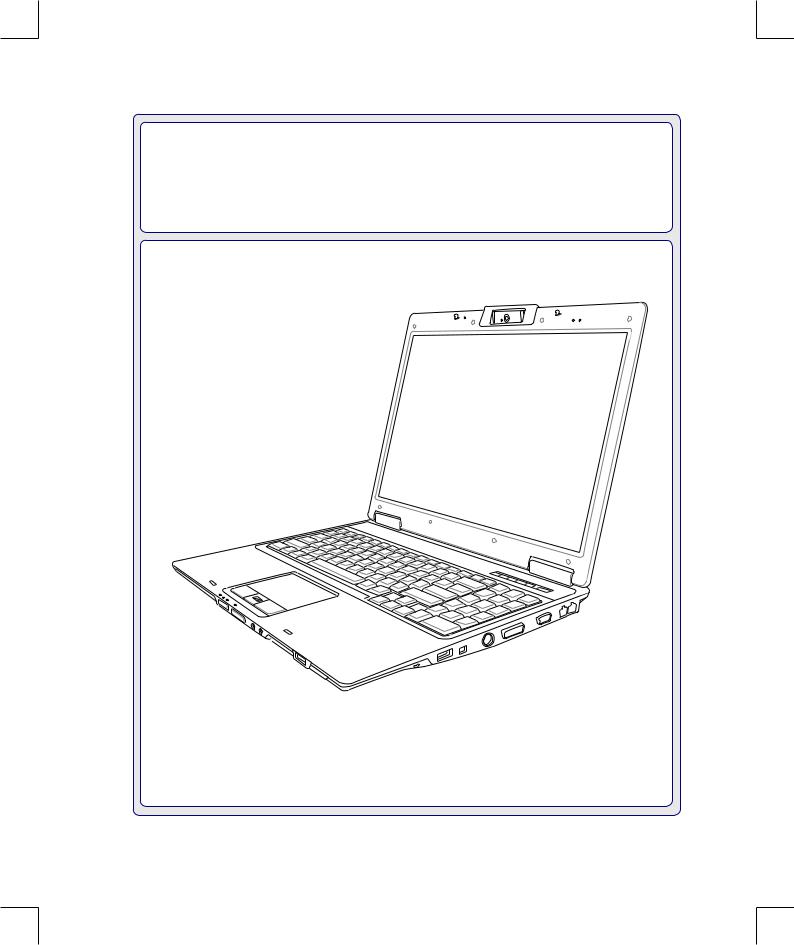
Notebook PC
Hardware User’s Manual
E3840 / May 2008

Contents
Table of Contents
Table of Contents
1. Introducing the Notebook PC
About This User’s Manual 6 Notes For This Manual 6
Preparing your Notebook PC 9
2. Knowing the Parts
Top Side 12 Bottom Side 15 Right Side 17 Left Side 20 Front Side 21 Rear Side 22
3. Getting Started
Power System 24 Using AC Power 24 Using Battery Power 25 Battery Care 25 Powering ON the Notebook PC 26 The Power-On Self Test (POST) 26 Checking Battery Power 27 Charging the Battery Pack 27 Power Options 28 Power Management Modes 29 Sleep and Hibernate 29 Thermal Power Control 29
Special Keyboard Functions 30 Colored Hot Keys 30 Microsoft Windows Keys 32 Extended Keyboard 32
Switches and Status Indicators 33 Switches 33 Status Indicators 34

Contents
Table of Contents (Cont.)
Multimedia Control Keys (on selected models) 36
4. Using the Notebook PC
Pointing Device 38 Using the Touchpad 38 Touchpad Usage Illustrations 39 Caring for the Touchpad 40 Automatic Touchpad Disabling 40
Storage Devices 41 Expansion Card 41 Optical Drive 42 Flash Memory Card Reader 44 Hard Disk Drive 45 Memory (RAM) 46
Connections 47 Modem Connection 47 Network Connection 48 Wireless LAN Connection (on selected models) 49 Windows Wireless Network Connection 50 Bluetooth Wireless Connection (on selected models) 51 Antenna Connections (on selected models) 52
Trusted Platform Module (TPM) (on selected models) 53
Appendix
Optional Accessories A-2 Optional Connections A-3 Bluetooth Mouse Setup (optional) A-4
Operating System and Software A-6 System BIOS Settings A-7 Common Problems and Solutions A-9 Windows Vista Software Recovery A-15
Glossary A-17 Declarations and Safety Statements A-21 Notebook PC Information A-32

Contents
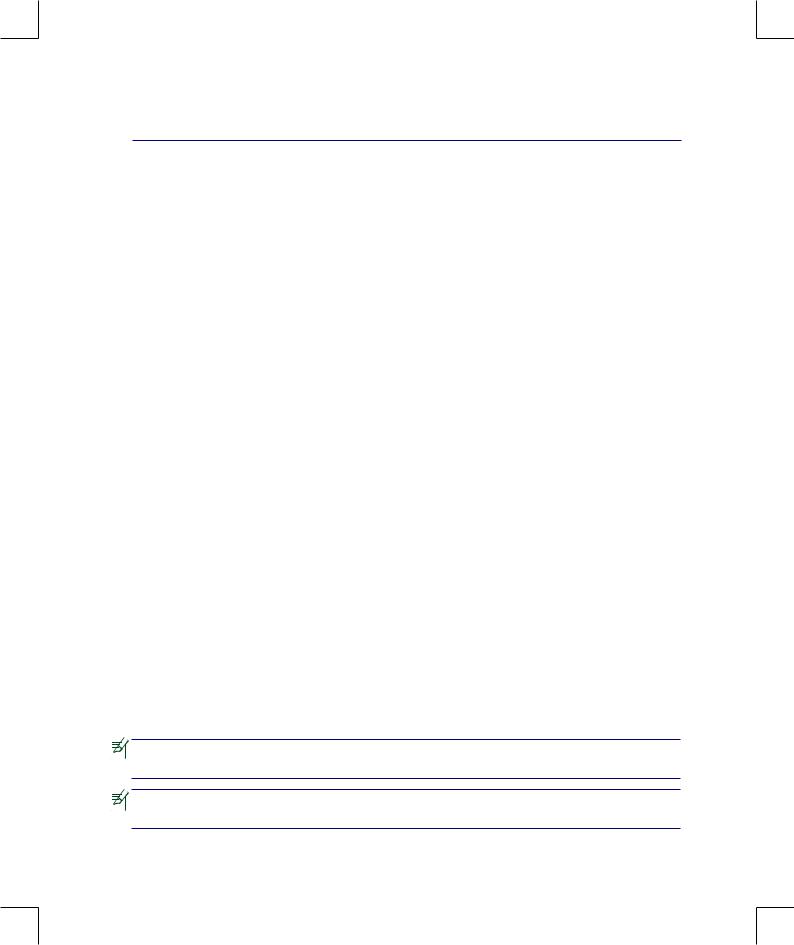
1. Introducing the Notebook PC
About This User’s Manual
Notes For This Manual
Safety Precautions
Preparing your Notebook PC
There may be differences between your Notebook PC and the drawings shown in this manual. Please accept your Notebook PC as being correct.
Photos and icons in this manual are used for artistic purposes only and do not show what is actually used in the product itself.
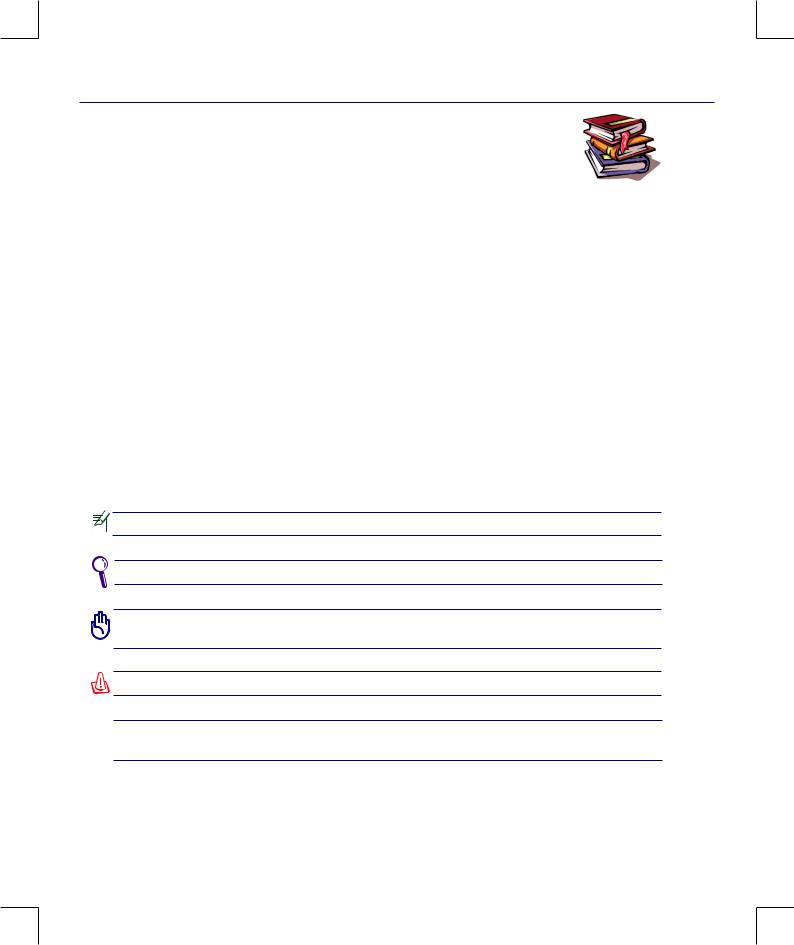
1 Introducing the Notebook PC
About This User’s Manual
You are reading the Notebook PC User’s Manual. This User’s Manual provides information on the various components in the Notebook PC and how to use them. The following are major sections of this User’s Manuals:
1.Introducing the Notebook PC
Introduces you to the Notebook PC and this User’s Manual.
2.Knowing the Parts
Gives you information on the Notebook PC’s components.
3.Getting Started
Gives you information on getting started with the Notebook PC.
4.Using the Notebook PC
Gives you information on using the Notebook PC’s components.
5.Appendix
Introduces you to optional accessories and gives additional information.
Notes For This Manual
A few notes and warnings in bold are used throughout this guide that you should be aware of in order to complete certain tasks safely and completely. These notes have different degrees of importance as described below:
< > [ ]
NOTE: Tips and information for special situations.
TIP: Tips and useful information for completing tasks.
IMPORTANT! Vital information that must be followed to prevent damage to data, components, or persons.
WARNING! Important information that must be followed for safe operation.
Text enclosed in < > or [ ] represents a key on the keyboard; do not actually type the < > or [ ] and the enclosed letters.

Introducing the Notebook PC 1
Safety Precautions
The following safety precautions will increase the life of the Notebook PC. Follow all precautions and instructions. Except as described in this manual, refer all servicing to qualified personnel. Do not use damaged power cords, accessories, or other peripherals. Do not use strong solvents such as thinners, benzene, or other chemicals on or near the surface.
IMPORTANT! Disconnect the AC power and remove the battery pack(s) before cleaning. Wipe the Notebook PC using a clean cellulose sponge or chamois cloth dampened with a solution of nonabrasive detergent and a few drops of warm water and remove any extra moisture with a dry cloth.
DO NOT place on uneven or unstable work surfaces. Seek servicing if the casing has been damaged.
DO NOT press or touch the display panel. Do not place together with small items that may scratch or enter the Notebook PC.
DO NOT expose to dirty or dusty environments. DO NOT operate during a gas leak.
DO NOT leave the Notebook PC on your lap or any part of the body in order to prevent discomfort or injury from heat exposure.
SAFE TEMP: This Notebook PC should only be used in environments with ambient temperatures between 5°C (41°F) and 35°C (95°F)
DO NOT throw the Notebook PC in municipal waste. Check local regulations for disposal of electronic products.
DO NOT place or drop objects on top and do not shove any foreign objects  into the Notebook PC.
into the Notebook PC.
DO NOT expose to strong magnetic or electrical fields.
DO NOT expose to or use near liquids, rain, or moisture. DO NOT use the modem during an electrical storm.
Battery safety warning:
DO NOT throw the battery in fire.
DO NOT short circuit the contacts.
DO NOT disassemble the battery.
INPUT RATING: Refer to the rating label on the bottom of the Notebook PC and be sure that your power adapter complies with the rating.
DO NOT carry or cover a Notebook PC that is powered ON with any materials that will reduce air circulation such as a carrying bag.
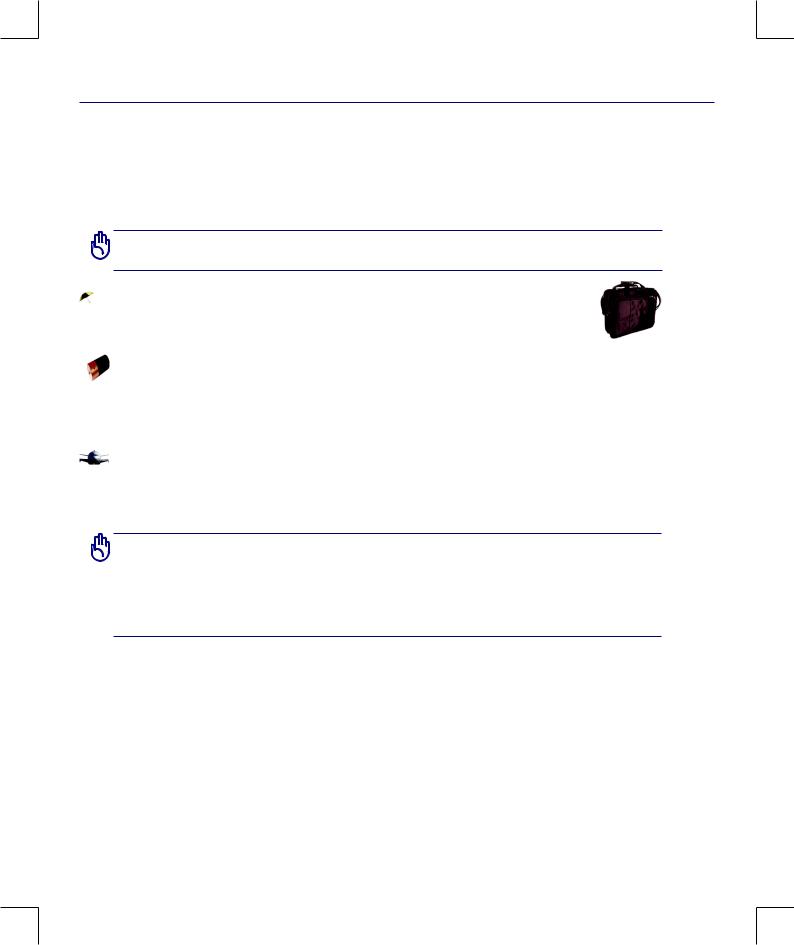
1 Introducing the Notebook PC
 Transportation Precautions
Transportation Precautions
To prepare the Notebook PC for transport, you should turn it OFF and disconnect all external peripherals to prevent damage to the connectors. The hard disk drive’s head retracts when the power is turned OFF to prevent scratching of the hard disk surface during transport. Therefore, you should not transport the Notebook PC while the power is still ON. Close the display panel and check that it is latched securely in the closed position to protect the keyboard and display panel.
CAUTION! The Notebook PC’s surface is easily dulled if not properly cared for. Be careful not to rub or scrape the Notebook PC surfaces.
Cover Your Notebook PC
Purchase a carrying bag to protect the Notebook PC from dirt, water, shock, and scratches.
Charge Your Batteries
If you intend to use battery power, be sure to fully charge your battery pack and any optional battery packs before going on long trips. Remember that the power adapter charges the battery pack as long as it is plugged into the computer and an AC power source. Be aware that it takes much longer to charge the battery pack when the Notebook PC is in use.
Airplane Precautions
Contact your airline if you want to use the Notebook PC on the airplane. Most airlines will have restrictions for using electronic devices. Most airlines will allow electronic use only between and not during takeoffs and landings.
CAUTION! There are three main types of airport security devices: X-ray machines (used on items placed on conveyor belts), magnetic detectors (used on people walking through security checks), and magnetic wands (hand-held devices used on people or individual items). You can send your Notebook PC and diskettes through airport X-ray machines. However, it is recommended that you do not send your Notebook PC or diskettes through airport magnetic detectors or expose them to magnetic wands.
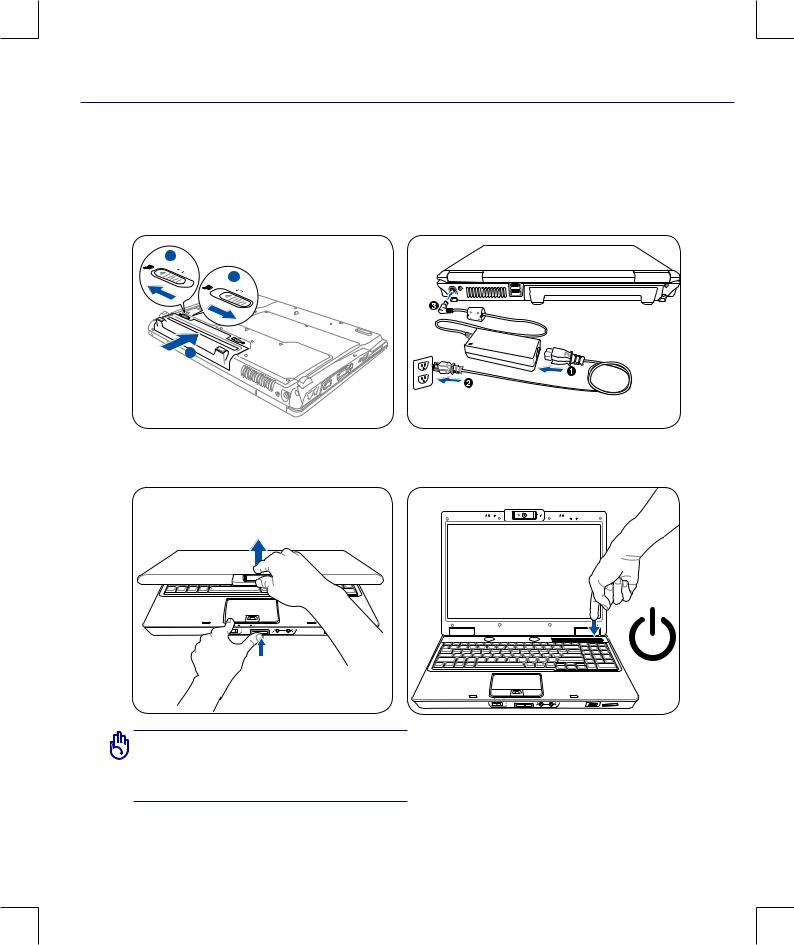
Introducing the Notebook PC 1
Preparing your Notebook PC
These are only quick instructions for using your Notebook PC. Read the later pages for detailed information on using your Notebook PC.
1. Install the battery pack |
2. Connect the AC Power Adapter |
1
1-
3
1-
2-
3. Open the Display Panel |
4. Turn ON the Notebook PC |
||||||||
|
|
|
|
|
|
|
|
|
|
|
|
|
|
|
|
|
|
|
|
|
|
|
|
|
|
|
|
|
|
|
|
|
|
|
|
|
|
|
|
IMPORTANT! When opening, do not force the display panel down to the table or else the hinges may break! Never lift the Notebook PC by the display panel!
The power switch turns ON and OFF the Notebook PC or putting the Notebook PC into sleep or hibernation modes. Actual behavior of the power switch can be customized in Windows Control Panel > Power Options > System Settings.

1 Introducing the Notebook PC
10

2. Knowing the Parts
Basic sides of the Notebook PC
There may be differences between your Notebook PC and the drawings shown in this manual. Please accept your Notebook PC as being correct.
Photos and icons in this manual are used for artistic purposes only and do not show what is actually used in the product itself.
11
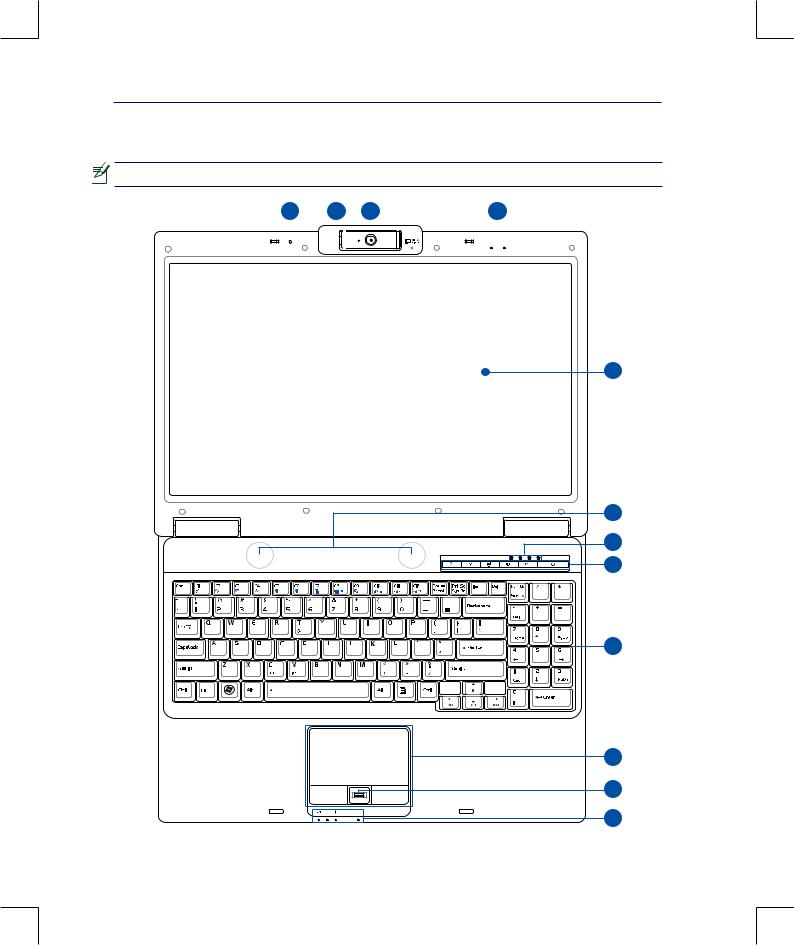
2 Knowing the Parts
Top Side
Refer to the illustration below to identify the components on this side of the Notebook PC.
The keyboard will be different for each territory.
1 |
2 |
3 |
|
|
|
4 |
|
||||||||
|
|
|
|
||||||||||||
|
|
|
|
|
|
|
|
|
|
|
|
|
|
|
|
|
|
|
|
|
|
|
|
|
|
|
|
|
|
|
|
|
|
|
|
|
|
|
|
|
|
|
|
|
|
|
|
|
|
|
|
|
|
|
|
|
|
|
|
|
|
|
|
5
6
7
8
9
10
11
12
12
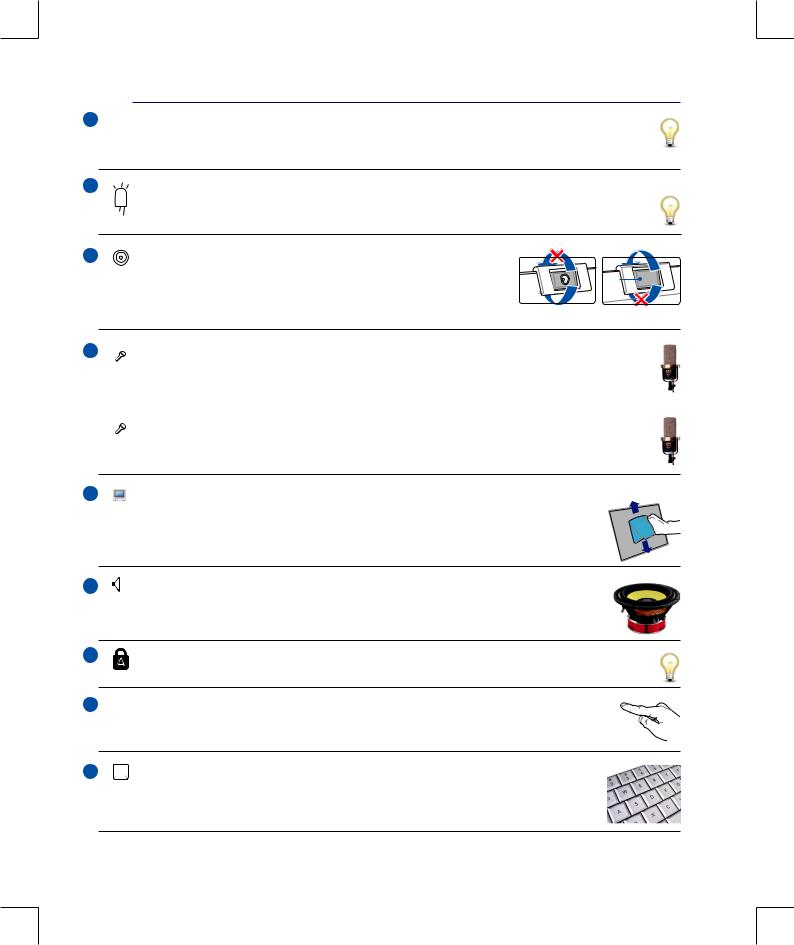
1
2
3
4
5
6
7
8
9
Knowing the Parts 2
Light Sensor (on selected models)
The light sensor measures the amount of ambient light and changes the illumination of the LCD display accordingly.
Camera Indicator (on selected models)
The camera indicator shows when the built-in camera is in use. The camera may be auto-activated by supported software.
Multi-Position Camera (on selected models)
The built-in camera allows picture taking or video recording. Can Front Back
Back
be used with video conferencing and other interactive applications.
CAUTION: The lens can be adjusted facing forward or facing backward 
 but the lens can only flip through the bottom. Do not rotate the lens upward past 35 degrees.
but the lens can only flip through the bottom. Do not rotate the lens upward past 35 degrees.
 Array Microphone (on selected models)
Array Microphone (on selected models)
The built-in array microphone is more clear and echo-free compared with traditional single microphones and can be used for video conferencing, voice narrations, audio recordings, and multimedia applications.
 Microphone (Built-in) (on selected models)
Microphone (Built-in) (on selected models)
The built-in mono microphone can be used for video conferencing, voice narrations, or simple audio recordings.
Display Panel
The Notebook PC uses an ultra-clear flat panel which provides excellent viewing like that of desktop monitors without any harmful radiation or flickering, so it is easier on the eyes.
Use a soft cloth without chemical liquids (use plain water if necessary) to clean the display panel. WARNING: The display panel is fragile. Do not to bend or press the panel.
 Audio Speaker System
Audio Speaker System
The built-in stereo speaker system allows you to hear audio without additional attachments. The multimedia sound system features an integrated digital audio controller that produces rich, vibrant sound (results improved with external stereo headphones or speakers).
Status Indicators (top)
Status indicators represent various hardware/software conditions. See indicator details in section 3.
 Instant Keys
Instant Keys
Instant keys allow you to launch frequently used applications with one push of a button. Details are described in section 3.


 Keyboard
Keyboard
The keyboard provides full-sized keys with comfortable travel (depth at which the keys can be depressed) and palm rest for both hands. Two Windows function keys are provided to help ease navigation in the Windows operating system.
13
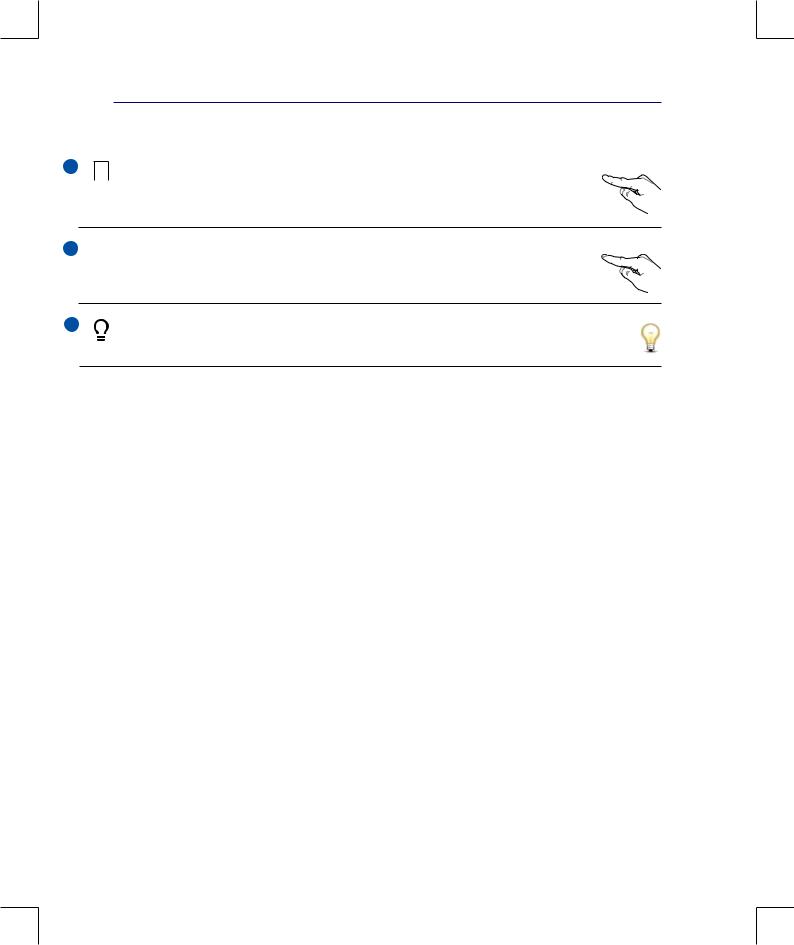
2 Knowing the Parts
10 Touchpad and Buttons
 The touchpad with its buttons is a pointing device that provides the same functions as a desk-
The touchpad with its buttons is a pointing device that provides the same functions as a desk-  top mouse. A software-controlled scrolling function is available after setting up the included touchpad utility to allow easy Windows or web navigation.
top mouse. A software-controlled scrolling function is available after setting up the included touchpad utility to allow easy Windows or web navigation.
11  Fingerprint Scanner (on selected models)
Fingerprint Scanner (on selected models)
The built-in fingerprint scanner allows use of security software using your fingerprint as your identification key.
12 |
Status Indicators (front) |
Status indicators represent various hardware/software conditions. See indicator details in section 3.
14
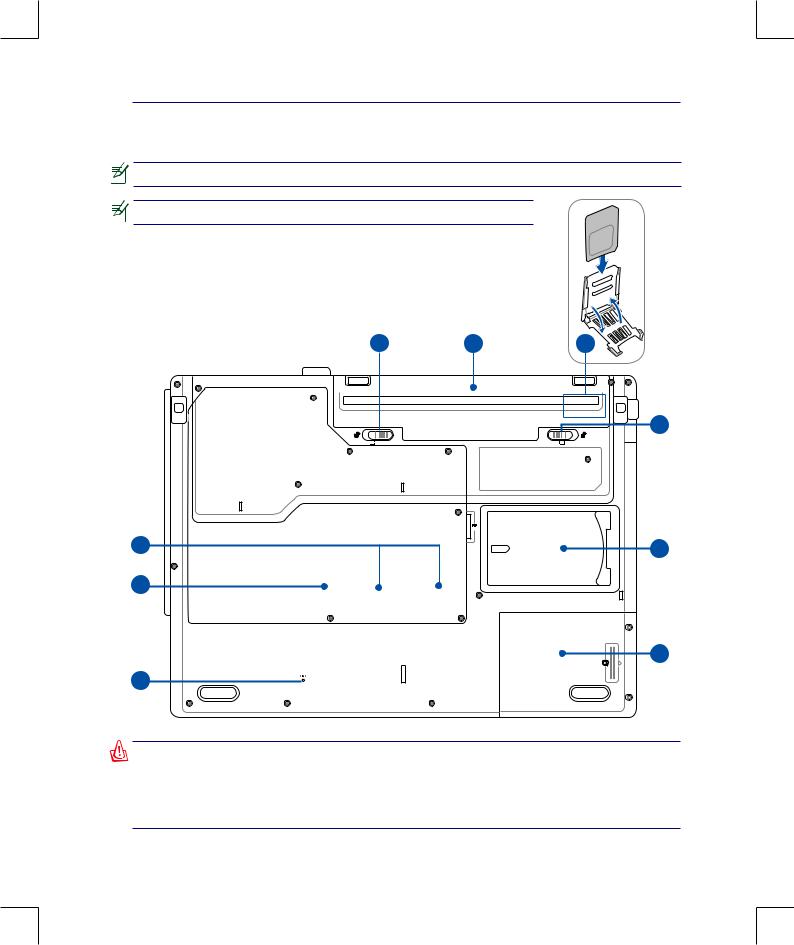
Knowing the Parts 2
Bottom Side
Refer to the illustration below to identify the components on this side of the Notebook PC.
The bottom side may vary in appearance depending on model.
The battery pack size will vary depending on model.
SIM Card Installation
1 2
4
-2 |
-1 |
9 |
5 |
8
6
7
WARNING! The bottom of the Notebook PC can get very hot. Be careful when handling the Notebook PC while it is in operation or recently been in operation. High temperatures are normal during charging or operation. Do not use on soft surfaces such as beds or sofas which may block the vents. DO NOT PUT THE NOTEBOOK PC ON YOUR LAP OR OTHER PARTS OF THE BODY TO AVOID INJURY FROM THE HEAT.
15
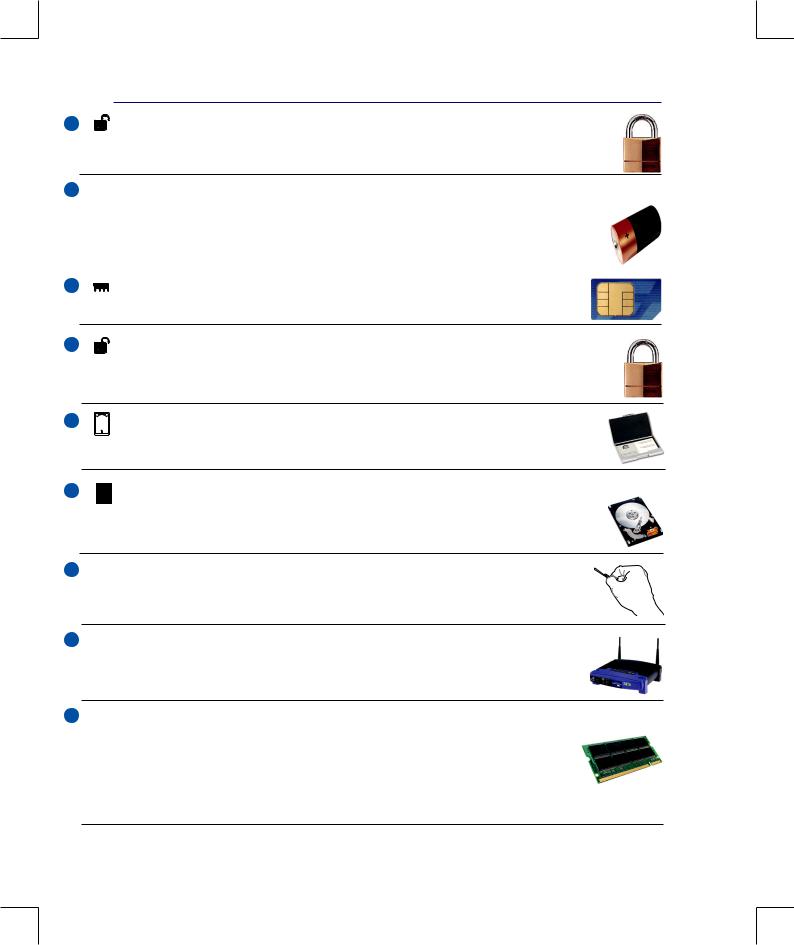
2 Knowing the Parts
1 Battery Lock - Spring
The spring battery lock is used to keep the battery pack secured. When the battery pack is inserted, it will automatically lock. To remove the battery pack, this spring lock must be held in the unlocked position.
2  Battery Pack
Battery Pack
The battery pack is automatically charged when the Notebook PC is connected to an AC power source andmaintainspowertotheNotebookPCwhenACpowerisnotconnected.Thisallowsusewhenmoving temporarilybetweenlocations.BatterytimevariesbyusageandbythespecificationsforthisNotebook
PC. The battery pack cannot be disassembled and must be purchased as a single unit.
3 |
SIM Card Compartment (on selected models) |
The SIM card compartment allows insertion of a mobile SIM card for 3G functions.
4 |
Battery Lock - Manual |
The manual battery lock is used to keep the battery pack secured. Move the manual lock to the unlocked position to insert or remove the battery pack. Move the manual lock to the locked position after inserting the battery pack.
5 |
Name Card Holder |
The Notebook PC has a name card holder glued to the bottom of the Notebook PC to hold identification information on the user in case the Notebook PC is found by others.
6 Hard Disk Drive Compartment
The hard disk drive is secured in a compartment. Visit an authorized service center or retailer for information on hard disk drive upgrades for your Notebook PC. Only purchase hard disk drives from authorized retailers of this Notebook PC to ensure maximum compatibility and reliability
7 

 Shutdown Button (Emergency)
Shutdown Button (Emergency)
In case your operating system cannot properly turn OFF or restart, the shutdown button can be pressed with a straightened paper clip to shutdown the Notebook PC.
8  Wireless LAN (WLAN) Compartment
Wireless LAN (WLAN) Compartment
The WLAN compartment allows the installation of a wireless networking card in order to wirelessly connect to network access points or other wireless networking devices.
9  Memory (RAM) Compartment
Memory (RAM) Compartment
The memory compartment provides expansion capabilities for additional memory. Additional memory will increase application performance by decreasing hard disk access. The BIOS au- tomatically detects the amount of memory in the system and configures accordingly. There is no hardware or software (including BIOS) setup required after the memory is installed. Visit an
authorized service center or retailer for information on memory upgrades for your Notebook PC. Only purchase expansion modules from authorized retailers of this Notebook PC to ensure maximum compatibility and reliability.
16
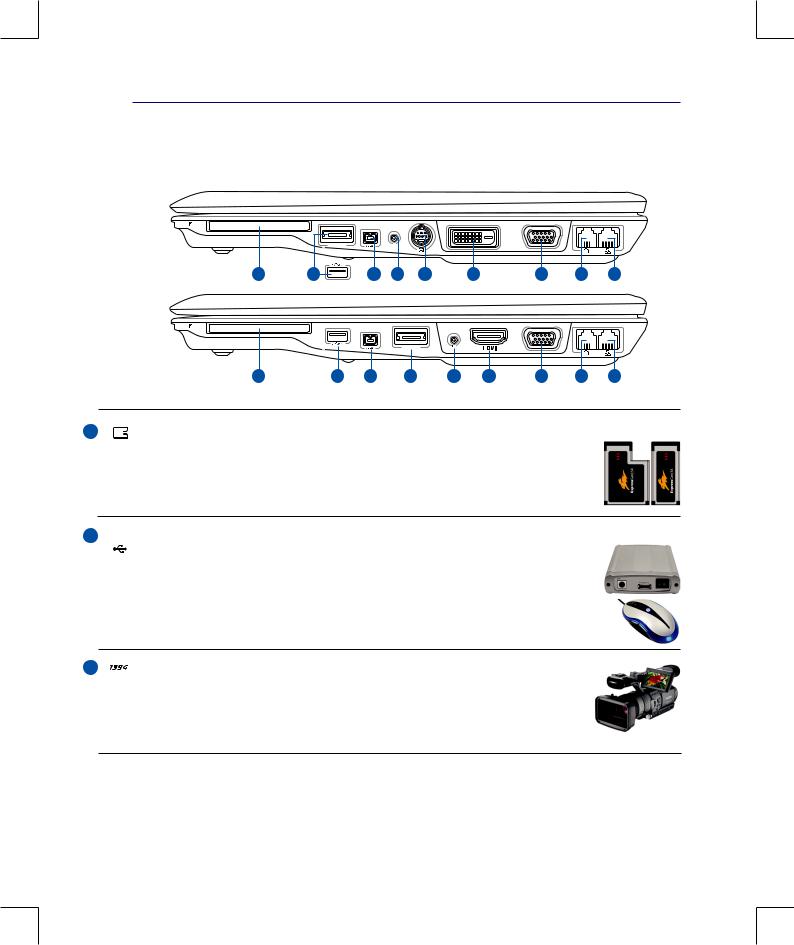
Knowing the Parts 2
Right Side
Refer to the illustration below to identify the components on this side of the Notebook PC. The components vary by model.
EXPRESS  EXPRESS
EXPRESS
E-SATA |
DVI |
|
1 |
2 |
3 |
4 |
5 |
6 |
7 |
8 |
9 |
EXPRESS  EXPRESS
EXPRESS
E-SATA
1 |
2 |
3 |
4 |
5 |
6 |
7 |
8 |
9 |
1 |
ExpressCard Slot |
One 26pin Express card slot is available to support one ExpressCard/34mm or one ExpressCard/54mm expansion card. This new interface is faster by using a serial bus supporting USB 2.0 and PCI Express instead of the slower parallel bus used in the PC card slot. (Not compatible with previous PCMCIA cards.)
2 E-SATA E-SATA or USB (2.0/1.1) Port (depending on model)
2.0External SATA or eSATA allows external connection of Serial-ATA devices originally designed for use inside the computer. It is up to six times faster than existing USB 2.0 and 1394 for external storage solutions and is also hot pluggable.
The USB (Universal Serial Bus) port is compatible with USB 2.0 or USB 1.1 devices such as keyboards, pointing devices, cameras, hard disk drives, printers, and scanners connected in a series up to 12Mbits/sec (USB 1.1) and 480Mbits/sec (USB 2.0).
3 |
IEEE1394 Port (on selected models) |
IEEE1394 is a high speed serial bus like SCSI but has simple connections and hotplugging capabilities like USB. The interface IEEE1394 has a bandwidth of 100-400 Mbits/sec and can handle up to 63 units on the same bus. IEEE1394 is also used in high-end digital equipment and should be marked “DV” for Digital Video port.
17
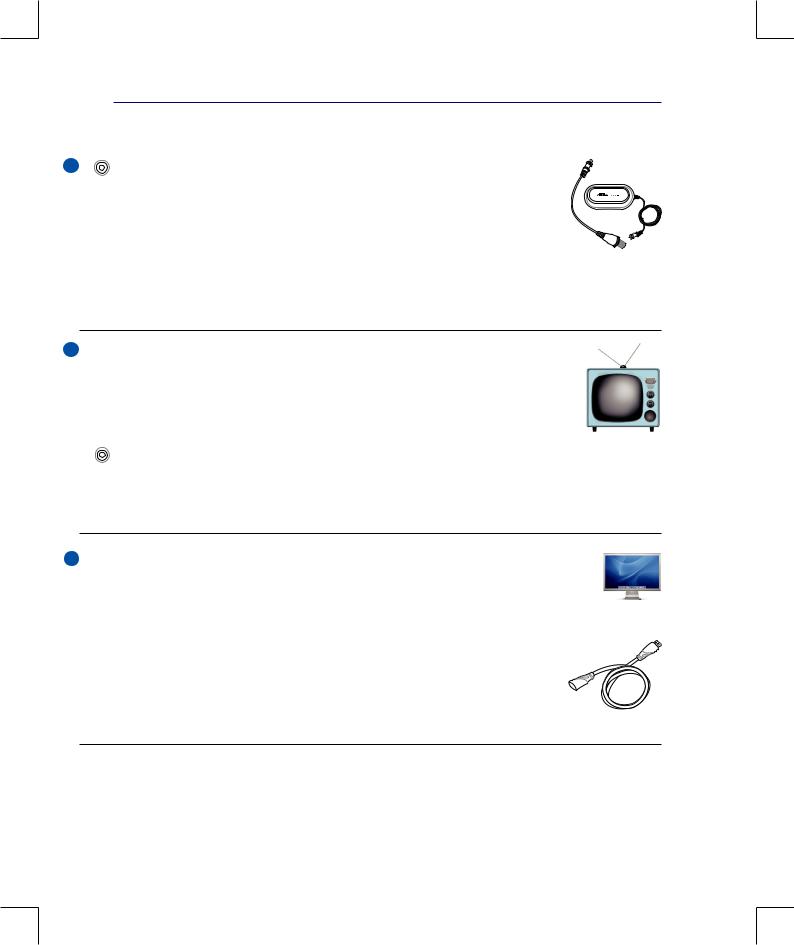
2 Knowing the Parts
4 Antenna Input (on selected models)
The antenna input is for TV or FM Radio (on selected models) frequency signal and
allows for use with the provided digital TV/FM antenna or input from subscription television services. The provided antenna can receive digital TV or FM radio. Cable service
connection can receive digital TV, analog TV, or FM radio depending on paid services.
Note: Use the provided adapter for use with coaxial connectors.
E-SATA E-SATA Port (on selected models)
External SATA or eSATA allows external connection of Serial-ATA devices originally designed for use inside the computer. It is up to six times faster than existing USB 2.0 and 1394 for external storage solutions and is also hot pluggable.
5 
 TV-Out Port (on selected models)
TV-Out Port (on selected models)
The TV-Out port is an S-Video connector that allows routing the Notebook PC’s display to a television or video projection device. You can choose between simultaneously or single display. Use an S-Video cable (not provided) for high quality displays or use the provided RCA to S-Video adapter for standard video devices. This port supports both NTSC and PAL formats.
Antenna Input (on selected models)
The antenna input is for TV or FM Radio (on selected models) frequency signal and allows for use with the provided digital TV/FM antenna or input from subscription television services. The provided antenna can receive digital TV or FM radio. Cable service connection can receive digital TV, analog TV, or FM radio depending on paid services. Note: Use the provided adapter for use with coaxial connectors.
6 DVI Display (DVI-D) Output (on selected models)
The Digital Video Interface port is designed to maximize video graphics output to flat panel LCD monitors or other DVI-compliant device.
HDMI HDMI Port (on selected models)
HDMI (High-Definition Multimedia Interface) is an uncompressed all-digital audio/ video interface between any audio/video source, such as a set-top box, DVD player, and A/V receiver and an audio and/or video monitor, such as a digital television
(DTV). Supports standard, enhanced, or high-definition video, plus multi-channel  digital audio on a single cable. It transmits all ATSC HDTV standards and supports
digital audio on a single cable. It transmits all ATSC HDTV standards and supports
8-channel digital audio, with bandwidth to spare to accommodate future enhancements or requirements.
18
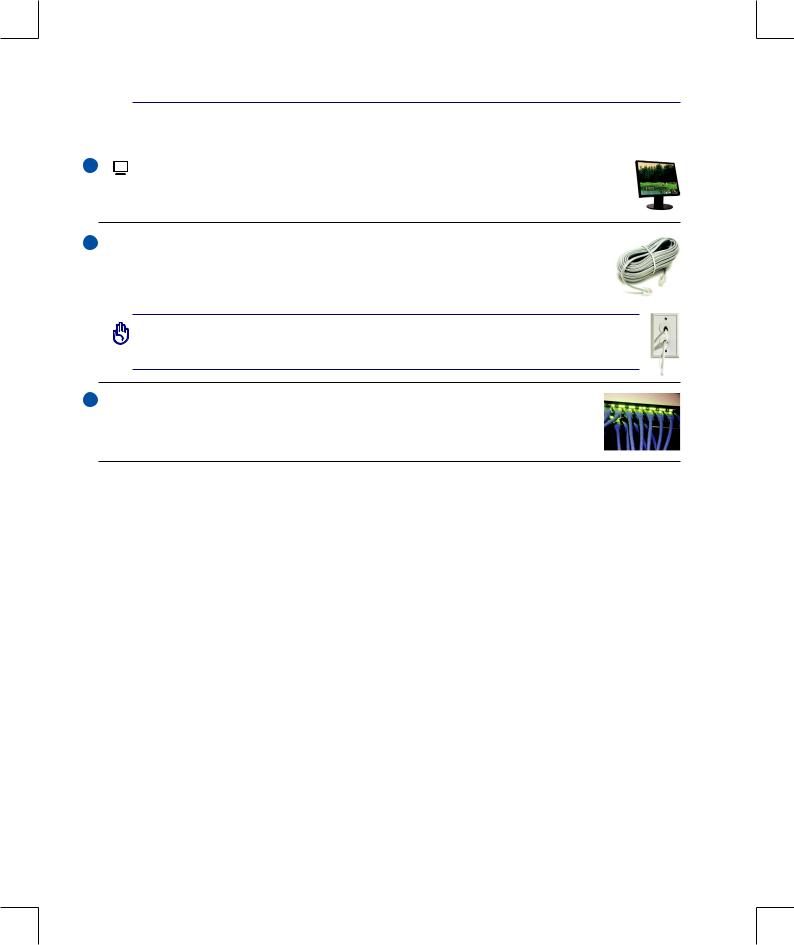
Knowing the Parts 2
7 |
Display (Monitor) Output |
The 15-pin D-sub monitor port supports a standard VGA-compatible device such as a monitor or projector to allow viewing on a larger external display.
8  Modem Port
Modem Port
The RJ-11 modem port with two pins is smaller than the RJ-45 LAN port and supports a standard telephone cable. The internal modem supports up to 56K V.90 transfers. The built-in connector allows convenient use without additional adapters.
IMPORTANT! The built-in modem does not support the voltage used in digital phone systems. Do not connect the modem port to a digital phone system or else damage will occur to the Notebook PC.
9  LAN Port
LAN Port
The RJ-45 LAN port with eight pins is larger than the RJ-11 modem port and supports a standard Ethernet cable for connection to a local network. The built-in connector allows convenient use without additional adapters.
19
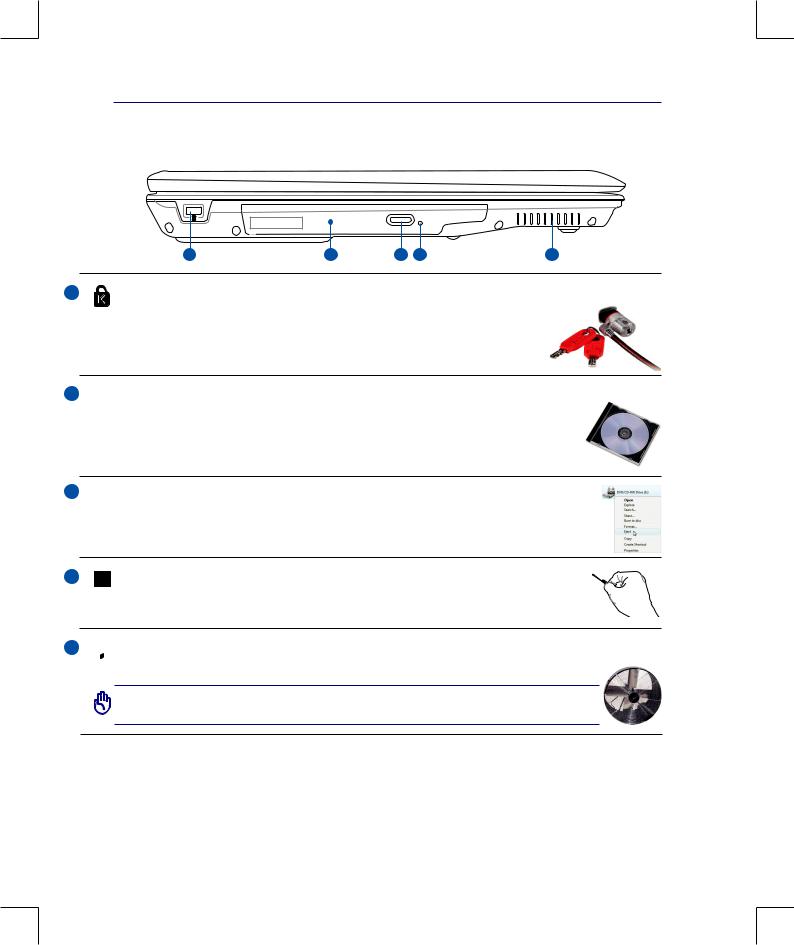
2 Knowing the Parts
Left Side
Refer to the illustration below to identify the components on this side of the Notebook PC.
1
2
3
1 |
2 |
3 |
4 |
5 |
Kensington® Lock Port
The Kensington® lock port allows the Notebook PC to be secured using Kensington® compatible Notebook PC security products. These security products usually include a metal cable and lock that prevent the Notebook PC to be removed from a fixed object.
Some may also include a motion detector to sound an alarm when moved.
 Optical Drive
Optical Drive
The Notebook PC comes in various models with different optical drives. The Notebook
PC’sopticaldrivemaysupportcompactdiscs(CD)and/ordigitalvideodiscs(DVD)and may have recordable (R) or re-writable (RW) capabilities. See the marketing specifica- tions for details on each model.
 Optical Drive Electronic Eject
Optical Drive Electronic Eject
The optical drive eject has an electronic eject button for opening the tray. You can also eject the optical drive tray through any software player or by right clicking the optical drive in
Windows “Computer” and selecting Eject.
4 Optical Drive Emergency Eject (location varies by model)
The emergency eject is used to eject the optical drive tray in case the electronic eject does not work. Do not use the emergency eject in place of the electronic eject.
5 
 Air Vents
Air Vents
The air vents allow cool air to enter and warm air to exit the Notebook PC.
IMPORTANT! Make sure that paper, books, clothing, cables, or other objects do not block any of the air vents or else overheating may occur.
20
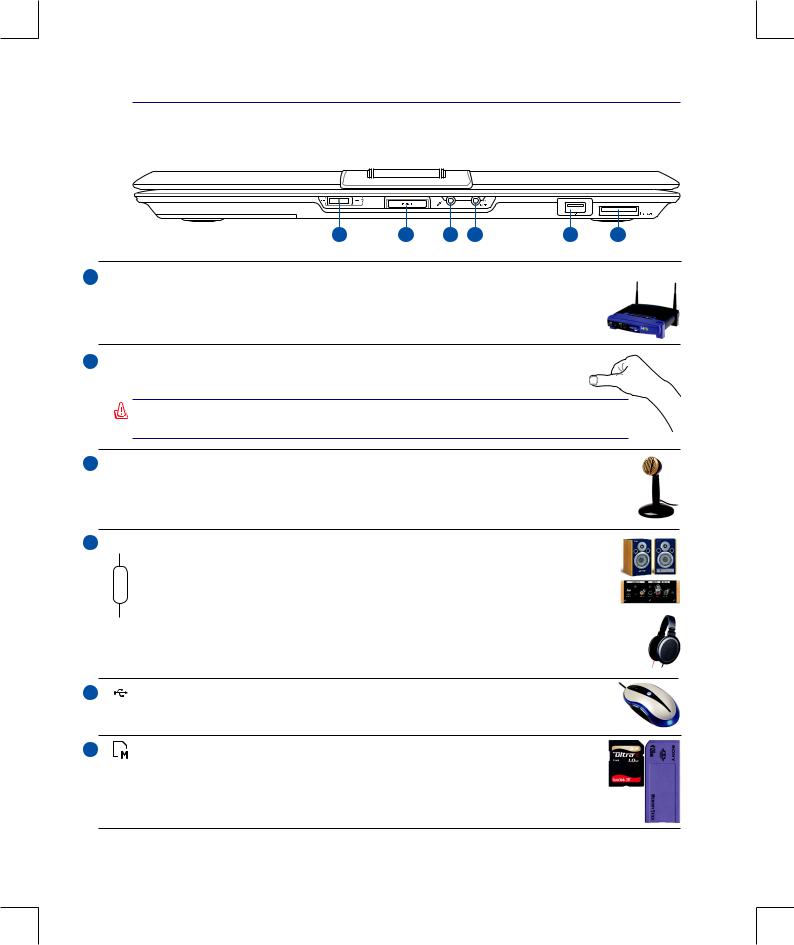
1
2
3
4
5
6
Knowing the Parts 2
Front Side
Refer to the illustration below to identify the components on this side of the Notebook PC.
1 |
2 |
3 |
4 |
5 |
6 |
 Wireless Switch
Wireless Switch
Enables or disables the built-in wireless LAN and Bluetooth (selected models). When enabled, the wireless status indicator will light. Windows software settings are necessary before use.
 Display Panel Button
Display Panel Button
Press the display panel button to open the display panel.
WARNING! When opening, do not force the display panel down to the table else the hinges may break! Never lift the Notebook PC by the display panel!
 Microphone Input Jack
Microphone Input Jack
The mono microphone jack (1/8 inch) can be used to connect an external microphone or output signals from audio devices. Using this jack automatically disables the built-in microphone. Use this feature for video conferencing, voice narrations, or simple audio recordings.
 SPDIF Output Jack
SPDIF Output Jack
Combo |
This jack provides connection to SPDIF (Sony/Philips Digital Interface) compliant de- |
vices for digital audio output. Use this feature to turn the Notebook PC into a hi-fi home |
|
|
entertainment system. |


 Headphone Output Jack
Headphone Output Jack
The stereo headphone jack (1/8 inch) is used to connect the Notebook PC’s audio out signal to amplified speakers or headphones. Using this jack automatically disables the built-in speakers.
2.0 USB Port (2.0/1.1)
(See other side for description.)
Flash Memory Slot
Normally an external memory card reader must be purchased separately in order to use memory cards from devices such as digital cameras, MP3 players, mobile phones, and
PDAs.This Notebook PC has a built-in high-speed memory card reader that can conveniently read from and write to many flash memory cards as mentioned later in this manual.
21
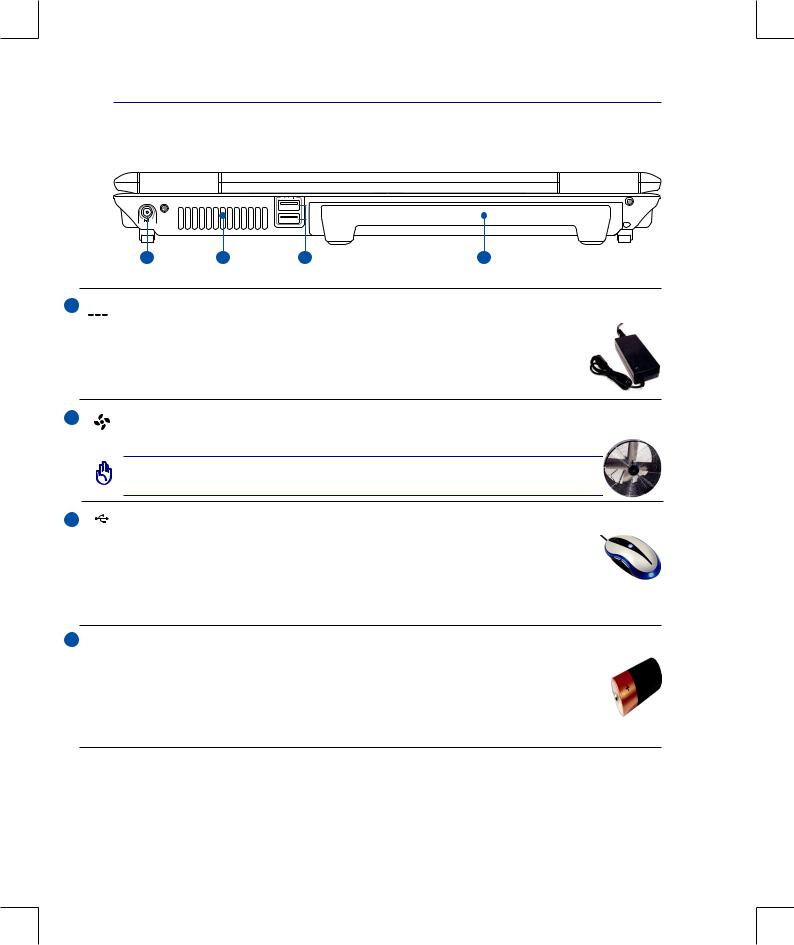
2 Knowing the Parts
Rear Side
Refer to the illustration below to identify the components on this side of the Notebook PC.
1 |
2 |
3 |
4 |
1  Power (DC) Input
Power (DC) Input
The supplied power adapter convertsAC power to DC power for use with this jack. Power sup- plied through this jack supplies power to the Notebook PC and charges the internal battery pack. To prevent damage to the Notebook PC and battery pack, always use the supplied power adapter. CAUTION: MAY BECOME WARM TO HOT WHEN IN USE. BE SURE
NOT TO COVER THE ADAPTER AND KEEP IT AWAY FROM YOUR BODY.
2 |
Cooling Fan |
The cooling fan removes excess heat depending on temperature threshold settings.
IMPORTANT! Make sure that paper, books, clothing, cables, or other objects do not block any of the air vents or else overheating may occur.
3 2.0 USB Port (2.0/1.1)
The USB (Universal Serial Bus) port is compatible with USB 2.0 or USB 1.1 devices such as keyboards, pointing devices, cameras, hard disk drives, printers, and scanners connected in a series up to 12Mbits/sec (USB 1.1) and 480Mbits/sec (USB 2.0). USB allows many devices to
run simultaneously on a single computer, with some peripherals acting as additional plug-in sites or hubs. USB supports hot-swapping of devices so that most peripherals can be connected or disconnected without restarting the computer.
4  Battery Pack
Battery Pack
The battery pack is automatically charged when the Notebook PC is connected to an AC power source andmaintainspowertotheNotebookPCwhenACpowerisnotconnected.Thisallowsusewhenmoving temporarilybetweenlocations.BatterytimevariesbyusageandbythespecificationsforthisNotebook
PC. The number of the battery cells housed in the battery pack varies with your purchase. The battery pack cannot be disassembled and must be purchased as a single unit.
22

3. Getting Started
Using AC Power
Using Battery Power
Powering ON the Notebook PC
Checking Battery Power
Powering Options
Power Management Modes
Special Keyboard Functions
Switches and Status Indicators
There may be differences between your Notebook PC and the drawings shown in this manual. Please accept your Notebook PC as being correct.
Photos and icons in this manual are used for artistic purposes only and do not show what is actually used in the product itself.
23
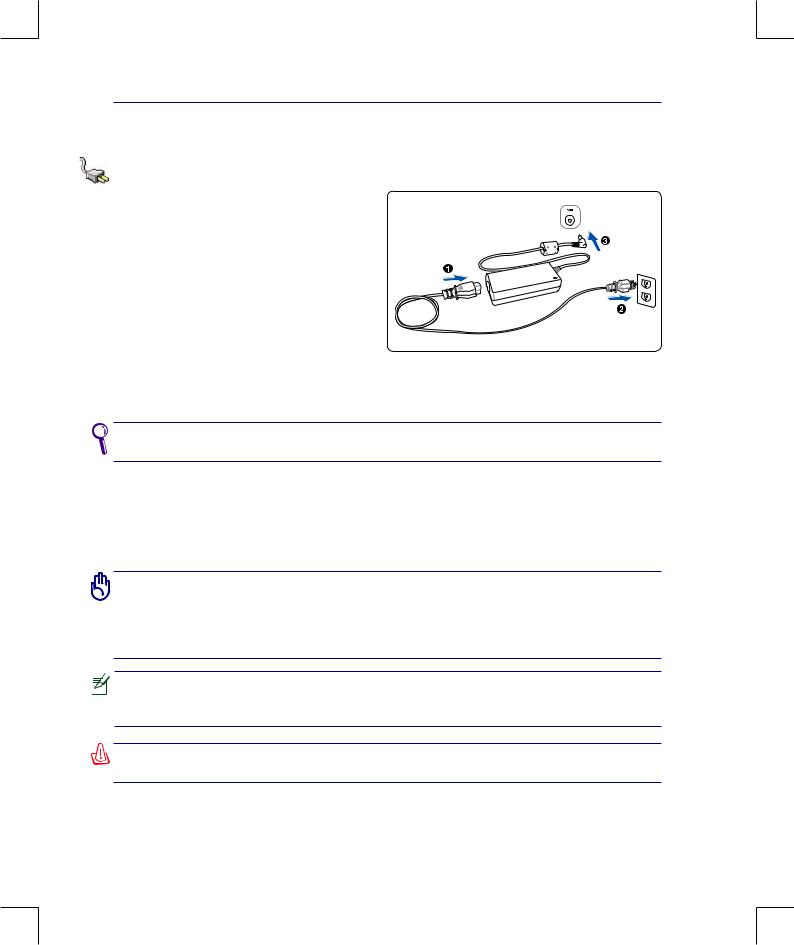
3 Getting Started
Power System
Using AC Power
The Notebook PC power is comprised of two parts, the power adapter and the battery power system.
The power adapter converts AC power from a wall outlet to the DC power required by the Notebook
PC. Your Notebook PC comes with a universal
AC-DC adapter.That means that you may connect
the power cord to any 100V-120V as well as 220V240V outlets without setting switches or using power converters. Different countries may require that an adapter be used to connect the provided
US-standard AC power cord to a different standard.
Most hotels will provide universal outlets to sup-
port different power cords as well as voltages. It is always best to ask an experienced traveler about AC outlet voltages when bringing power adapters to another country.
You can buy travel kits for the Notebook PC that includes power and modem adapters for almost every country.
With theAC power cord connected to theAC-DC converter, connect theAC power cord to anAC outlet (preferably with surge-protection) and then connect the DC plug to the Notebook PC. Connecting the AC-DC adapter to theAC outlet first allows you to test theAC outlet’s power and theAC-DC converter itself for compatibility problems before connecting the DC power to the Notebook PC. The power indi- cator on the adapter (if available) will light if the power is within accepted ranges.
IMPORTANT! Damage may occur if you use a different adapter to power the Notebook PC or use the Notebook PC’s adapter to power other electrical devices. If there is smoke, burning scent, or extreme heat coming from the AC-DC adapter, seek servicing. Seek servicing if you suspect a faulty AC-DC adapter. You may damage both your battery pack(s) and the Notebook PC with a faulty AC-DC adapter.
This Notebook PC may come with either a two or three-prong plug depending on territory. If a three-prong plug is provided, you must use a grounded AC outlet or use a properly grounded adapter to ensure safe operation of the Notebook PC.
WARNING! THE POWER ADAPTER MAY BECOME WARM TO HOT WHEN IN USE. BE SURE NOT TO COVER THE ADAPTER AND KEEP IT AWAY FROM YOUR BODY.
24
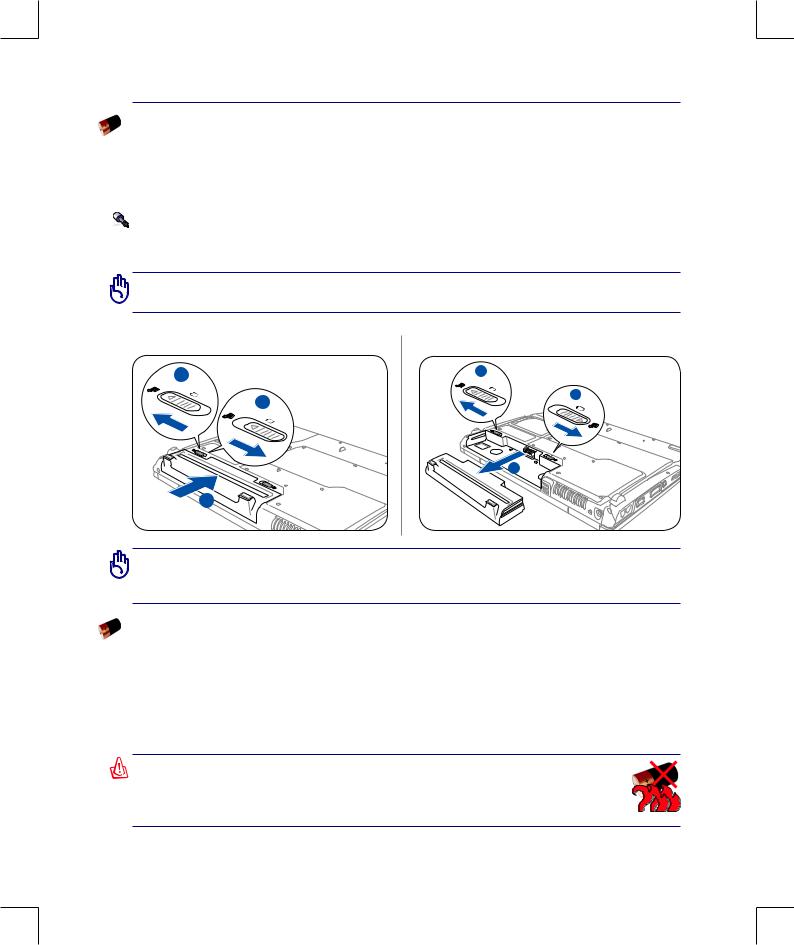
Getting Started 3
Using Battery Power
The Notebook PC is designed to work with a removable battery pack. The battery pack consists of a set of battery cells housed together. A fully charged pack will provide several hours of battery life, which can be further extended by using power management features through the BIOS setup. Additional battery packs are optional and can be purchased separately through a Notebook PC retailer.
Installing and Removing the Battery Pack |
Your Notebook PC may or may not have its battery pack installed. If your Notebook PC does not have its battery pack installed, use the following procedures to install the battery pack.
IMPORTANT! Never attempt to remove the battery pack while the Notebook PC is turned ON, as this may result in the loss of working data.
To install the battery pack:
1
1- |
3 |
|
1- |
To remove the battery pack:
1
1- |
2 |
|
2- |
2-
2-
IMPORTANT! Only use battery packs and power adapters supplied with this Notebook
PC or specifically approved by the manufacturer or retailer for use with this model or else damage may occur to the Notebook PC.
Battery Care
The Notebook PC’s battery pack, like all rechargeable batteries, has a limit on the number times it can be recharged. The battery pack’s useful life will depend on your environment temperature, humidity, and how your Notebook PC is used. It is ideal that the battery be used in a temperature range between 5˚C and 35˚C (41˚F and 95˚F).You must also take into account that the Notebook PC’s internal temperature is higher than the outside temperature. Any temperatures above or below this range will shorten the life of the battery. But in any case, the battery pack’s usage time will eventually decrease and a new battery pack must be purchased from an authorized dealer for this Notebook PC. Because batteries also have a shelf life, it is not recommended to buy extras for storing.
WARNING! For safety reasons, DO NOT throw the battery in fire, DO NOT short circuit the contacts, and DO NOT disassemble the battery. If there is any abnormal operation or damage to the battery pack caused by impact, turn OFF the Notebook PC and contact an authorized service center.
25
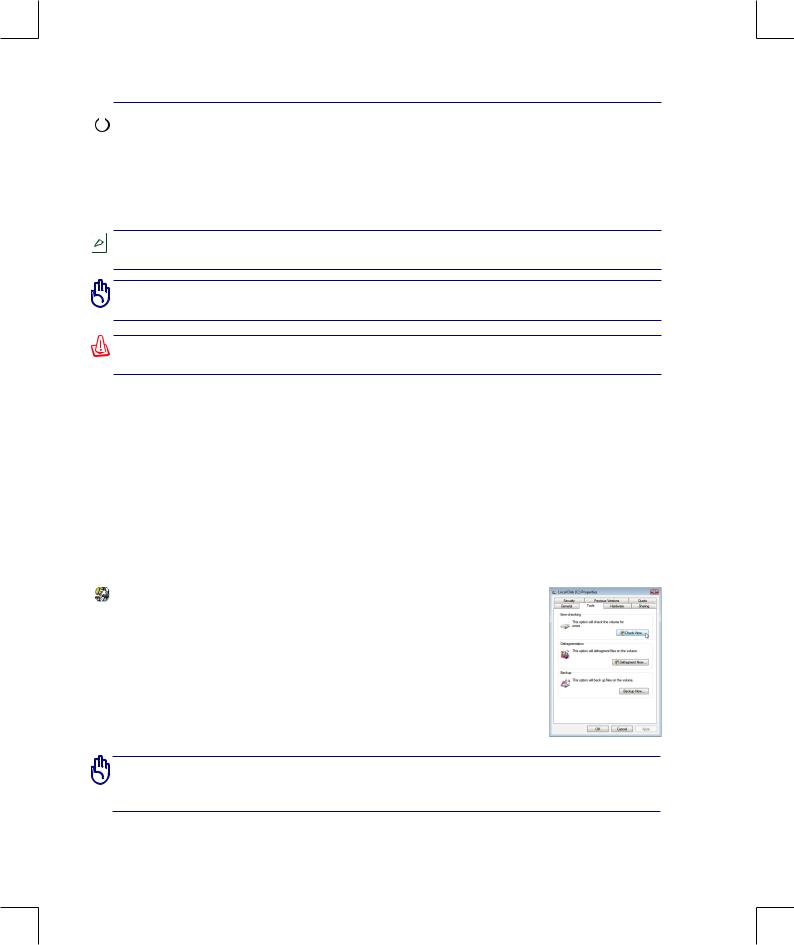
3 Getting Started
 Powering ON the Notebook PC
Powering ON the Notebook PC
The Notebook PC’s power-ON message appears on the screen when you turn it ON. If necessary, you may adjust the brightness by using the hot keys. If you need to run the BIOS Setup to set or modify the system configuration, press [F2] upon bootup to enter the BIOS Setup. If you press [Tab] during the splashscreen,standardbootinformationsuchastheBIOSversioncanbeseen.Press[ESC]andyouwill be presented with a boot menu with selections to boot from your available drives.

 Before bootup, the display panel flashes when the power is turned ON. This is part of the Notebook PC’s test routine and is not a problem with the display.
Before bootup, the display panel flashes when the power is turned ON. This is part of the Notebook PC’s test routine and is not a problem with the display.
IMPORTANT! To protect the hard disk drive, always wait at least 5 seconds after turning OFF your Notebook PC before turning it back ON.
WARNING! DO NOT carry or cover a Notebook PC that is powered ON with any materials that will reduce air circulation such as a carrying bag.
 The Power-On Self Test (POST)
The Power-On Self Test (POST)
When you turn ON the Notebook PC, it will first run through a series of software-controlled diagnos- tic tests called the Power-On Self Test (POST). The software that controls the POST is installed as a permanent part of the Notebook PC’s architecture. The POST includes a record of the Notebook PC’s hardware configuration, which is used to make a diagnostic check of the system. This record is created by using the BIOS Setup program. If the POST discovers a difference between the record and the exist- ing hardware, it will display a message on the screen prompting you to correct the conflict by running
BIOS Setup. In most cases the record should be correct when you receive the Notebook PC. When the test is finished, you may get a message reporting “No operating system found” if the hard disk was not preloaded with an operating system. This indicates that the hard disk is correctly detected and ready for the installation of a new operating system.
Self Monitoring and Reporting Technology
The S.M.A.R.T. (Self Monitoring and Reporting Technology) checks the hard disk drive during POST and gives a warning message if the hard disk drive requires servicing. If any critical hard disk drive warning is given during bootup, backup your data immediately and run Windows disk checking program. To run Window’s disk checking program: click Start > select Computer > right-click a hard disk drive icon > choose Properties > click the Tools tab > click Check Now > click
Start.You can also select “Scan ... sectors” for more effective scan and repair but the process will run slower.
IMPORTANT! If warnings are still given during bootup after running a software disk checking utility, you should take your Notebook PC in for servicing. Continued use may result in data loss.
26
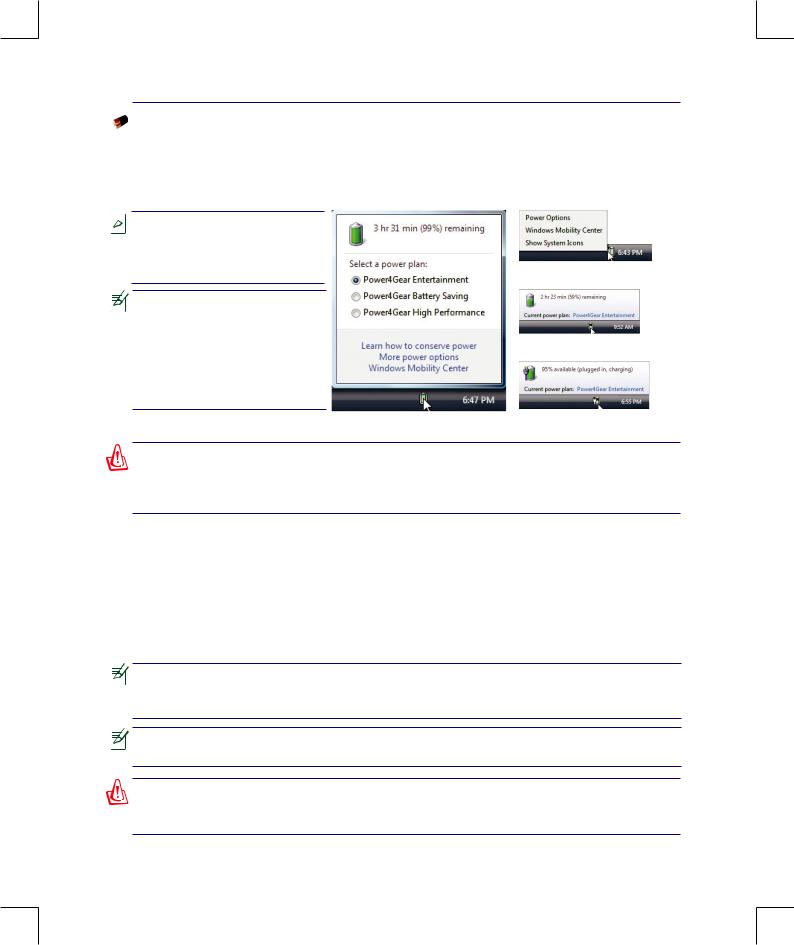
Getting Started 3
Checking Battery Power
The battery system implements the Smart Battery standard under the Windows environment, which allows the battery to accurately report the amount of charge left in the battery. A fully-charged battery pack provides the Notebook PC a few hours of working power. But the actual figure varies depending on how you use the power saving features, your general work habits, the CPU, system memory size, and the size of the display panel.

 Screen captures shown here are examples only and may not reflect what you see in your system.
Screen captures shown here are examples only and may not reflect what you see in your system.
You will be warned when battery power is low. If you continue to ignore the low battery warnings, the Notebook PC eventually enters suspend mode (Windows default uses STR).
Left-click the battery icon
Right-click the battery icon
Pointer over the battery icon without power adapter.
Pointer over the battery icon with power adapter.
WARNING! Suspend-to-RAM (STR) does not last long when the battery power is depleted. Suspend-to-Disk (STD) is not the same as power OFF. STD requires a small amount of power and will fail if no power is available due to complete battery depletion or no power supply (e.g. removing both the power adapter and battery pack).
 Charging the Battery Pack
Charging the Battery Pack
Before you use your Notebook PC on the road, you will have to charge the battery pack. The battery pack begins to charge as soon as the Notebook PC is connected to external power using the power adapter.
Fullychargethebatterypackbeforeusingitforthefirsttime.Anewbatterypackmustcompletelycharge before the Notebook PC is disconnected from external power. It takes a few hours to fully charge the battery when the Notebook PC is turned OFF and may take twice the time when the Notebook PC is turned ON. The battery status indicator on the Notebook PC turns OFF when the battery pack is charged.
The battery starts charging when the charge remaining in the battery drops below 95%. This prevents the battery from charging frequently. Minimizing the recharge cycles helps prolong battery life.
The battery stops charging if the temperature is too high or the battery voltage is too high.
WARNING! DO NOT leave the battery pack discharged. The battery pack will discharge over time. If not using a battery pack, it must continued to be charged every three months to extend recovery capacity or else it may fail to charge in the future.
27
